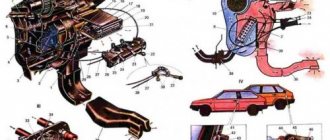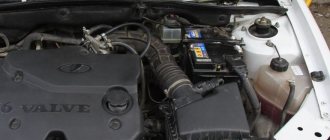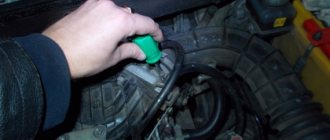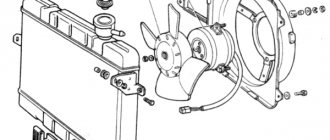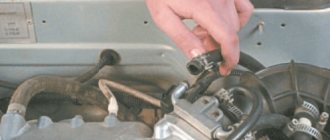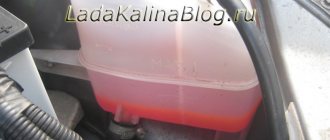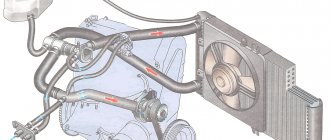When the owner purchases a new car, he has an undeniable advantage, because he can feel and remember how each component or unit works, which is in an unworn condition. After some mileage, the happy owner of a new Lada Kalina already has a clear idea of how a good car should function. Over time, almost all components are subject to natural wear and tear and the first breakdowns begin to occur. This is immediately noticed by the owner, and all his efforts are concentrated on eliminating the defect that has manifested itself.
The main signs of the presence of an air lock
The most reliable factor indicating that air has entered the cooling circuit is a deterioration in the efficiency of the heating system in the cabin. Therefore, many people are concerned about the question: how to remove air from the system? If the air lock is large enough, Lada Kalina owners may notice a characteristic “murmur” coming from under the panel. Thus, the stove betrays itself, through the lines of which antifreeze circulates in “steam” with air.
It is also not uncommon for a plug to form directly inside the thermostat housing. A sign here is a very long warm-up of the engine. The temperature indicator needle remains at the beginning of the scale for a long time. An air lock in the cooling system prevents the valve inside the thermostat from closing, forcing fluid to circulate in a large cooling circle. And it is important to know how to remove air from the system.
How to determine if there is a problem: symptoms, signs, diagnosis
Diagnostics are designed to help find the cause of malfunctioning cooling system. If antifreeze constantly disappears somewhere, boils, boils strongly in the cooling radiator, and the interior does not heat up, all this needs to be dealt with. If the antifreeze level regularly drops, air will take its place, which over time will form an air lock. In this case, you need to check the tightness of all connections of the engine cooling system. To do this, carry out a careful external inspection of the interfaces of rubber parts (hoses, pipes) with tubes and fittings with a warm, running engine. Pay special attention to the radiator pipes, water pump, thermostat and heater hoses. If a leak is detected, it must be eliminated by replacing the pipes or tightening the steel clamps.
The main burden of adjusting (while the engine is warming up) and maintaining a constant (while the engine is running) temperature in the cooling system falls on the thermostat. If the engine begins to warm up very quickly after starting, the electric fan starts almost simultaneously, and the arrow on the indicator tends to move into the red zone - these signs indicate a malfunction of the thermostat or an accumulation of air in the discharge pipe from the pump. The thermostat valve will be closed all the time, and the antifreeze will circulate only in a small circle.
Air accumulation in the thermostat: process diagram
But if the engine takes a long time to warm up, and the needle is frozen at the beginning of the scale, this is a sign of a constantly open valve at the thermostat or the formation of an air lock in the thermostat itself. An open valve cannot switch the antifreeze circulation to a small circle to quickly warm up the engine.
In what cases is air able to enter the system?
An air lock can enter the cooling circuit in three main situations, namely:
- when the owner ineptly fills in antifreeze or replenishes the system to the required level;
- if a partial depressurization of the circuit occurs, implying the penetration of an air plug through loose connections of the lines with the elements of the system;
- when a malfunction occurs in the valve present in the expansion tank plug (the valve is necessary to relieve excess pressure from the specified container). And then you will need information on how to remove air from the system.
About design defects of the system
Over time, the owners discovered three significant design flaws in the circulation system of the Lada Kalina engine cooler. They allow air to gradually accumulate inside the circuit, leading to the formation of the well-known plug. When air is present in a sufficiently small volume, the circulation process is only slightly disrupted, which is so far tolerated by the system painlessly. Here, a thermostat is connected as a control element, raising the temperature of the antifreeze (before opening the valve). If you do nothing in this situation, then as air accumulates under the pressure of the plugs, the stove will “give up,” reminding the owner of itself with the previously mentioned “murmuring” and lack of heat supply.
- The location of the expansion tank is below the upper level of antifreeze in the system.
- Frequent failure of the valve in the tank cap plug.
- Gradual loosening of the clamps holding the pipes at the joints with the circuit elements. Here, over time, there is a danger of not only the plug penetrating into the system while the engine is running, but also creating the risk of fluid leaking out.
General recommendations for prevention
The first thing you need to pay attention to is the level of antifreeze in the cooling system . Always monitor it and top up if necessary. Moreover, if you have to add coolant very often, then this is the first call indicating that something is wrong with the system, and additional diagnostics are necessary to identify the cause of the malfunction. Also check for stains from antifreeze leaks. It is better to do this in the inspection hole.
Try to use the antifreeze recommended by your car manufacturer. Make purchases in trusted, licensed stores, minimizing the likelihood of purchasing a counterfeit. The fact is that low-quality coolant can gradually evaporate during repeated heating, and instead of it, an air plug forms in the system. Therefore, do not neglect the manufacturer's requirements.
Instead of a conclusion
Finally, I would like to note that if the described signs of airing in the system appear, it is necessary to carry out diagnostics and check it as quickly as possible. After all, an air lock significantly reduces the efficiency of the cooling system. Because of this, the engine operates under conditions of increased wear, which can lead to premature failure. Therefore, if you detect airing, try to get rid of the plug as quickly as possible. Fortunately, even a novice car enthusiast can do this, since the procedure is simple and does not require the use of additional tools or devices.
During operation, the car engine is cooled by a non-freezing liquid circulating through the water jacket and the main radiator. In normal operation, the small and large circulation circuits are hermetically sealed and under pressure. But if air penetrates into the pipelines from the outside, the movement of antifreeze will stop and the engine will begin to overheat. To avoid unpleasant consequences associated with repairing the power unit, you should remove the air lock from the cooling system. Why it occurs and how to remove it correctly is described in detail in this manual.
Reasons for air getting into the system
There are enough reasons why air pockets form inside the cooling circuit of the Lada Kalina engine. Among them we will highlight the main ones.
- Loss of system tightness, which is manifested by an intensively decreasing level of refrigerant (can be observed by the marks of the expansion tank).
- A valve in the tank cap breaks down, causing the antifreeze to begin to boil at a lower pressure, which inevitably causes plugs to appear. Now the question remains: how to remove the air.
The reason for the appearance of an air lock in the cooling system
Cooling systems of modern vehicles are designed for stable high pressure (up to 100 kPa). This design makes it possible to increase the boiling point of the liquid to 120-125 degrees.
However, such a temperature range and effective cooling of the motor are only possible when the system is fully operational. One of the most common problems in the cooling system is the occurrence of air plugs.
The main causes of air locks include:
- entry of air through leaky joints of pipes, hoses, tubes due to changes in pressure that occur during the movement of the working fluid of the cooling system, which lead to air being drawn in through loose joints;
- injection of air when using a funnel with a wide neck, while in the process of adding liquid, its flow prevents gas from escaping, trapping it in the tank;
- increased wear of individual parts of the water pump (fiber, gaskets and seals), through cracks and cracks in which air can be sucked in;
- leakage of coolant through pipes, heater and cooling radiators, hoses, which causes a decrease in the level of antifreeze and filling of the free space in the expansion tank with air;
- obstruction of the channels in the radiator, which causes cooling problems and the appearance of air bubbles;
- malfunction of the valve releasing excess pressure in the cover of the expansion tank, which leads to air being sucked in and the impossibility of releasing it through the same valve;
- damage to the cylinder head gasket, leading to coolant entering the oil through the crankcase (a sign is an increase in the oil level and a change in its color) or into the exhaust system (smoke from the muffler becomes white), which causes a decrease in the volume of antifreeze and filling of the free space with air.
How to “drive out” a traffic jam?
There are several ways to eliminate a blockage in the cooling circuit of the Lada Kalina power plant. Next, let's look at their features and how to remove air.
Method one
The location of the throttle assembly appears as a design convenience for the LADA Kalina cooling circuit. It is located at the highest point of the system. The procedure for eliminating a traffic jam is as follows.
- We set the heater temperature switch (knob in the cabin) to maximum.
- Under the hood, remove the valve cover protective panel.
- Use a screwdriver (cross-shaped) to loosen the clamp and remove the rubber inlet pipe from the throttle body fitting (you can also resort to removing the outlet hose).
- Unscrew the cap on the expansion tank.
- Now we use our own mouth. With its help and through a sterile cloth, we pump the air accumulated in the lungs into the expansion tank. We do this until antifreeze appears from the specified fitting.
- If this is successful, then return the hose to its place, secure it and screw the cap onto the tank.
However, this is not the only method of removing air.
Method two
Its principle closely echoes the manipulations in the first method. There is no need to get your mouth dirty or even open the tank lid. All actions boil down to:
- warm up the engine to operating temperature and turn it off;
- carefully removes the same hose from the throttle assembly;
- We observe liquid flowing out of the fitting: if it appears, then return the hose and tighten the clamp;
- a one-time manipulation may not be successful, so we repeat the procedure again until the liquid appears.
Method three
Let's look at another option for pumping air. Let us immediately note that this method is not particularly effective. The actions do not involve disassembling the system.
- Here you will need to drive your front wheels onto an embankment so that the highest point of the contour is the air plug in the cooling system on the radiator housing.
- It must be removed, as well as the cap on the expansion tank.
- We start the engine and bring the temperature in the circuit to the operating parameter.
- We observe a decrease in the volume of antifreeze in the LADA Kalina tank and immediately replenish it to the required level. During the process, air bubbles will be released from the liquid.
- We carry out the action until the release of air stops, as evidenced by the absence of “foaming” of the liquid inside the tank.
- We return the previously removed plug and cover to their original places.
Recommendations for prevention
It is much easier to avoid the appearance of air in the cooling system than to later eliminate the causes of engine overheating.
To do this, you need to follow the simplest recommendations:
- pour antifreeze into the expansion tank in a thin stream without using a wide funnel;
- periodically conduct a visual inspection of pipes, hoses and places of their attachment for leaks and damage, if any, replace the damaged element;
- regularly change the cooling system pump according to the manufacturer’s requirements;
- constantly monitor the level of working fluid in the tank and, if necessary, immediately top it up;
- check the oil level and if it increases, it is necessary to urgently carry out diagnostics, since this most likely means damage to the cylinder head gasket.
If symptoms of airiness occur, they can be easily eliminated by replacing worn parts and removing gas using simple methods that can be accomplished even by a novice driver in terms of complexity.
The formation of air in the cooling system and, as a result, overheating of the engine can be easily prevented by periodically inspecting the condition of the system, adding antifreeze in a timely manner and replacing the water pump and damaged parts in accordance with the manufacturer’s regulations.
Let's sum it up
As you can see, an air lock in the cooling system is a significant obstacle to the normal functioning of the cooling system in the LADA Kalina car. It can not only cause the stove to become ineffective, but also cause more significant damage to the engine. Eliminating this negative phenomenon is not difficult, especially since now you know how to pump air, but the best measure would be timely and periodic diagnosis of the engine cooling system. It consists of checking the refrigerant level, the tightness of the circuit (reliability of clamps) and the functionality of the thermostat (control of heating of the lower radiator pipe).
The Lada Granta passenger car, which is considered one of the most affordable in the world, is equipped with a “stove” (or simply a heater) that is standard for VAZ cars. Typically this unit works very well, but problems can still occur. Therefore, if the Lada Granta stove does not heat well, then there must be reasons for this that simply need to be discovered.
see also
Oil in antifreeze
Antifreeze reducing additives
Antifreeze is boiling
Why does antifreeze go away?
How to add antifreeze
The presence of air in the cooling system is fraught with problems for both the engine and other components of the car. In particular, overheating may occur or the stove will heat poorly. Therefore, it is useful for any motorist to know how to remove an air lock from the cooling system. This procedure is quite trivial, so even a beginner and inexperienced car enthusiast can do it. Due to its importance, we will talk about three methods of removing air. But first, let's talk about how to understand that air jams are occurring and the reasons for their occurrence.
We carry out diagnostics
If it is cold outside and the interior cannot warm up properly, then you need to check the operation of the cooling system, which has a direct effect on heating the interior.
Coolant level
To do this, you need to open the hood and, with the engine not warmed up, check where the coolant is located.
If its level in the tank is between the minimum and maximum marks, then everything is in order. But, when this level decreases, problems with the tightness of the cooling system are possible, and this leads to a decrease in pressure inside the system. If the problem is not corrected, the stove will not be able to warm the air in the cabin effectively enough.
Additional Tips
However, it also happens that the problem with heating the interior consists only of some small mistakes. Therefore, before you start disturbing the service center workers, check whether all the dampers on the stove are set in the required position. It wouldn’t hurt to tug the hot air damper a little.
There is a possibility that it is simply stuck. And, with a significant push, it will be moved from its place.
According to reviews of many car owners, the Lada Kalina car is recognized as one of the warmest cars of domestic production. It is very warm in the car in winter, the interior is evenly heated and the rear passengers in the car are comfortable, since the hot air from the stove is supplied to the feet of the rear passengers in full and is not “lost” in the air tunnels of the ventilation system as in cars 2109 and 2110.
If one day it became cool inside the Lada Kalina car, and instead of the usual hot air, cold air began to blow from the stove, then there was a problem in the car’s engine cooling system. Malfunction of the cooling system can cause the engine to overheat to critical temperatures and lead to serious engine damage. An air lock can cause many problems in the cooling system of a Lada Kalina car. Before removing the plug, it is first recommended to check the entire car engine cooling system (SOD), since the cause of ineffective operation of the SOD and a cold stove can be not only an air lock in the system, but also a breakdown or deformation of the pump impeller, kinks in the pipes, or incomplete opening of the thermostat . Only after checking the entire cooling system should you begin to remove the air lock.
Signs of an air lock in the engine cooling system
An air lock creates an obstacle in the cooling system, due to which antifreeze or antifreeze cannot circulate and evenly cool a running engine.
Reasons for the appearance of an air lock in the engine cooling system:
— Air may enter the system when replacing or adding coolant.
— In the engine cooling system, there is a leak in external air due to weak compression of plastic fittings, loose clamps, a leaking radiator, a leak in the pump and a faulty expansion tank cap valve. One of the signs of a plug in the ODS is the gurgling of coolant under the instrument panel when the engine warms up.
To remove the plug, you need to loosen the clamp and remove tube 3 or 22 from the heating of the throttle assembly
— The cylinder head gasket (cylinder head) was blown. As a result of the breakdown, a coolant leak is visible from under the cylinder head. Exhaust gases escape from under the cylinder head, you can see the bubbling of antifreeze, the formation of an emulsion in the expansion tank, and white steam in the car exhaust.
An air lock in the SOD can form in both the small and large circulation circles. The disadvantage of Kalina's SOD is the location of the expansion tank in a large circle. As a result, until the thermostat opens completely, it is difficult to remove the airlock. Therefore, in the cold season, “gasification” helps, as a result of which the car warms up faster, and when the engine reaches a temperature of 101-105 degrees. The thermostat opens a large circulation circle and the air exits into the expansion tank.
Removing the air lock is only possible through the highest point of the cooling system. The method of understanding the front of the car, accelerating and letting the engine run for the Lada Kalina is not effective, because... in a closed system, air can only escape through the expansion tank. Rather, it will be more effective to lift the left side of the car, where the expansion tank is located, to release air from the SOD.
Elements of the Lada Granta cooling system
- stove heater radiators;
- electric pump;
- engine;
- throttle assembly;
- thermostat;
- antifreeze temperature sensor;
- overheat indicator;
- viscous fan drive coupling;
- fan;
- radiator cap;
- radiator;
- expansion tank cap;
- expansion tank;
- water pump;
- drain valve of the lower circuit.
And also, pipes of the Lada Granta cooling system, metal clamps - ties.
Thermostat
The cooling device on the Lada Grant is the main link in the chain. Performs the function of a valve that redirects the flow of antifreeze from a small to a large circle. When the operating temperature is below 94°, the thermostat is in the closed position. The liquid circulates in a small circle without “entering” the radiator.
New thermostat
According to this movement pattern, the heating of the liquid occurs many times faster. When the antifreeze heats up, the valve opens slightly, starting circulation in a large circle into the water jacket line.
Most often, a thermostat malfunction is associated with its boiling or jamming due to overheating. The part cannot be repaired; it must be replaced with a new, serviceable one.
Related link:
Adjusting the clutch pedal on the Lada Granta. Expert advice on self-replacement
Water pump (pump)
Forces antifreeze to circulate through the jacket (system). Structurally, the pump is located inside the engine, closer to the gas distribution mechanism (GRM). Moreover, it has a common drive with the timing belt.
Water pump
The average service life of the pump is 80 – 85 thousand km. Due to the frequent violation of regulations by the driver, the purchase of cheap analogues instead of original spare parts, the part wears out prematurely.
Radiator and fan
Cooling radiator
The radiator is designed to cool antifreeze. The standard fan also performs this function, but only after the operating temperature reaches a critical level of 100°.
Fan
How quickly the fan activates depends on the health of the temperature sensor. The latter monitors the degree online and sends the readings to the electronic engine control unit (ECU) to adjust the operation of the mechanisms.
Failure of the sensor leads to boiling of the engine. Many car owners have encountered this problem.
Connecting hoses and water jacket
Hoses serve as a link, connecting all mechanisms to each other. Frequent malfunctions are associated with a violation of the integrity, tightness of the system, and low levels of antifreeze.
Cooling system pipes
The water jacket is designed to circulate antifreeze throughout the system and remove excess heat. Damage to the jacket will result in water hammer inside. When using antifreeze, the risk of water hammer is 27% lower, in contrast to distilled water.
Expansion tank
The fluid level in the cooling system decreases and increases depending on the actual temperature. To compensate for the amount of antifreeze, an expansion tank is pre-installed in the design of the cooling system.
Expansion tank
The accessory material is heat-resistant polymer. On the outer surface there is a gradation of scales: minimum, maximum, recommended level. The tank is sealed with a sealed lid with a gasket.
When the pressure in the system reaches 1.1 kgf/sq. cm, the valve opens and releases the excess. The pressure in the system stabilizes. When the temperature of the liquid drops, to prevent vacuum, the inlet valve opens and replenishes the missing amount of air. How much antifreeze is in the Lada Granta cooling system: 7.5 liters up to about and 8.0 liters up to the recommended level.
Related link:
Experts' recommendations for replacing an automatic/manual transmission on a Lada Grant
The main signs of the presence of an air lock
The most reliable factor indicating that air has entered the cooling circuit is a deterioration in the efficiency of the heating system in the cabin. Therefore, many people are concerned about the question: how to remove air from the system? If the air lock is large enough, Lada Kalina owners may notice a characteristic “murmur” coming from under the panel. Thus, the stove betrays itself, through the lines of which antifreeze circulates in “steam” with air.
It is also not uncommon for a plug to form directly inside the thermostat housing. A sign here is a very long warm-up of the engine. The temperature indicator needle remains at the beginning of the scale for a long time. An air lock in the cooling system prevents the valve inside the thermostat from closing, forcing fluid to circulate in a large cooling circle. And it is important to know how to remove air from the system.
Cooling system Lada Granta - 8 and 16 valves, with and without air conditioning
| Name | Peculiarity |
| The engine cooling system (hereinafter referred to as SOD) of the Lada Granta family is completely identical to the Lada Kalina | Heater radiator, single-pass, low resistance, aluminum, brazed, high efficiency |
| The radiator is built into a small circuit, unlike previous generations | |
| The thermostat has one valve, not two, as was previously the case | |
| The thermostat controls the flow of antifreeze through the radiator | |
| The interior heating system has been improved by removing more heat from the heater radiator | Increased flow of antifreeze through the radiator at a small circle of rotation |
| One-way passage pattern instead of two-way | |
| Aluminum pipes are flat instead of cylindrical | |
| Soldering is used at all stages of articulation | |
| No chance of airing | Changing the angle of inclination of the antifreeze supply/return lines |
| Improved aerodynamic performance | |
| Fine tuning of engine operating temperature | |
| Increased operational efficiency due to | Changes in ignition timing |
| Economical fuel consumption mode |
In what cases is air able to enter the system?
An air lock can enter the cooling circuit in three main situations, namely:
- when the owner ineptly fills in antifreeze or replenishes the system to the required level;
- if a partial depressurization of the circuit occurs, implying the penetration of an air plug through loose connections of the lines with the elements of the system;
- when a malfunction occurs in the valve present in the expansion tank plug (the valve is necessary to relieve excess pressure from the specified container). And then you will need information on how to remove air from the system.
About design defects of the system
Over time, the owners discovered three significant design flaws in the circulation system of the Lada Kalina engine cooler. They allow air to gradually accumulate inside the circuit, leading to the formation of the well-known plug. When air is present in a sufficiently small volume, the circulation process is only slightly disrupted, which is so far tolerated by the system painlessly. Here, a thermostat is connected as a control element, raising the temperature of the antifreeze (before opening the valve). If you do nothing in this situation, then as air accumulates under the pressure of the plugs, the stove will “give up,” reminding the owner of itself with the previously mentioned “murmuring” and lack of heat supply.
- The location of the expansion tank is below the upper level of antifreeze in the system.
- Frequent failure of the valve in the tank cap plug.
- Gradual loosening of the clamps holding the pipes at the joints with the circuit elements. Here, over time, there is a danger of not only the plug penetrating into the system while the engine is running, but also creating the risk of fluid leaking out.
Reasons for air getting into the system
There are enough reasons why air pockets form inside the cooling circuit of the Lada Kalina engine. Among them we will highlight the main ones.
- Loss of system tightness, which is manifested by an intensively decreasing level of refrigerant (can be observed by the marks of the expansion tank).
- A valve in the tank cap breaks down, causing the antifreeze to begin to boil at a lower pressure, which inevitably causes plugs to appear. Now the question remains: how to remove the air.
How to “drive out” a traffic jam?
There are several ways to eliminate a blockage in the cooling circuit of the Lada Kalina power plant. Next, let's look at their features and how to remove air.
Method one
The location of the throttle assembly appears as a design convenience for the LADA Kalina cooling circuit. It is located at the highest point of the system. The procedure for eliminating a traffic jam is as follows.
- We set the heater temperature switch (knob in the cabin) to maximum.
- Under the hood, remove the valve cover protective panel.
- Use a screwdriver (cross-shaped) to loosen the clamp and remove the rubber inlet pipe from the throttle body fitting (you can also resort to removing the outlet hose).
- Unscrew the cap on the expansion tank.
- Now we use our own mouth. With its help and through a sterile cloth, we pump the air accumulated in the lungs into the expansion tank. We do this until antifreeze appears from the specified fitting.
- If this is successful, then return the hose to its place, secure it and screw the cap onto the tank.
However, this is not the only method of removing air.
Method two
Its principle closely echoes the manipulations in the first method. There is no need to get your mouth dirty or even open the tank lid. All actions boil down to:
- warm up the engine to operating temperature and turn it off;
- carefully removes the same hose from the throttle assembly;
- We observe liquid flowing out of the fitting: if it appears, then return the hose and tighten the clamp;
- a one-time manipulation may not be successful, so we repeat the procedure again until the liquid appears.
Method three
Let's look at another option for pumping air. Let us immediately note that this method is not particularly effective. The actions do not involve disassembling the system.
- Here you will need to drive your front wheels onto an embankment so that the highest point of the contour is the air plug in the cooling system on the radiator housing.
- It must be removed, as well as the cap on the expansion tank.
- We start the engine and bring the temperature in the circuit to the operating parameter.
- We observe a decrease in the volume of antifreeze in the LADA Kalina tank and immediately replenish it to the required level. During the process, air bubbles will be released from the liquid.
- We carry out the action until the release of air stops, as evidenced by the absence of “foaming” of the liquid inside the tank.
- We return the previously removed plug and cover to their original places.
How to bleed air from the cooling system - all methods
On many vehicle models, getting rid of an air lock in the coolant system is quite easy and even a non-professional can do, which will save a significant amount.
ATTENTION. Before carrying out this procedure, the sources of air in the system should be eliminated.
There are three methods for bleeding air yourself:
1) It is necessary to place the car on a level surface and remove the upper protection from the motor. In many models, the throttle assembly is the highest point in the cooling system.
If, during a visual inspection, the same feature is found on a specific model of vehicle, then to bleed the air it is necessary to remove the antifreeze supply pipe from the throttle assembly by loosening the clamp with a Phillips screwdriver; it would not be superfluous to open the heater switch to the hottest mode (this procedure is especially relevant for VAZs ).
Then you should unscrew the cap from the expansion tank and cover the hole with a clean cloth and start blowing air into the tank with your mouth until coolant begins to pour out of the pipe, which will mean removing the plug. Then you should secure the pipe and screw on the cap.
2) You should first warm up the internal combustion engine for 10-20 minutes (depending on the outside temperature). Then unscrew the cap from the expansion tank and remove the antifreeze supply pipe from the throttle module.
After coolant begins to flow out of the pipe, it should be returned to its place, carefully securing the clamp. When carrying out this procedure, it is necessary to avoid contact of the working fluid with the skin and clothing to avoid burns.
3) It is necessary to put the vehicle on the handbrake on an inclined surface (with the front part on the rise); additional wheel chocks will not be superfluous.
Next, you should start the engine and let it run for 10-20 minutes to heat the coolant and open the thermostat. Then carefully, so as not to get burned, you should remove the cap from the expansion tank and radiator.
During this procedure, you should regularly lightly depress the accelerator pedal and add antifreeze (antifreeze), it would not be superfluous to turn on the stove to the hottest setting to bleed air from the heating system.
The release of the plug will be manifested by the appearance of bubbles; after they completely disappear and/or very hot air appears from the heating system, you can turn off the engine and return the covers to their place, as this will mean complete removal of air from the cooling system.
This method is not always effective, since some design features may not allow this procedure to be completed. This method is most effective on old cars, including VAZs.
Self-bleeding of air is based on elementary physical laws - air is a gas, and gas is lighter than liquid, and additional procedures increase the pressure in the system, speeding up the flow of liquid and removal of air.
ATTENTION. The procedure for bleeding air should be carried out with extreme caution to avoid burns from the coolant, since its temperature can exceed 80 degrees.
Let's sum it up
As you can see, an air lock in the cooling system is a significant obstacle to the normal functioning of the cooling system in the LADA Kalina car. It can not only cause the stove to become ineffective, but also cause more significant damage to the engine. Eliminating this negative phenomenon is not difficult, especially since now you know how to pump air, but the best measure would be timely and periodic diagnosis of the engine cooling system. It consists of checking the refrigerant level, the tightness of the circuit (reliability of clamps) and the functionality of the thermostat (control of heating of the lower radiator pipe).
Signs or Symptoms of a Stifled Engine Cooling System
Air in the cooling system can cause serious engine problems. To avoid this, you should know the obvious symptoms when air appears in the cooling system.
- overheating of the internal combustion engine, expressed in a rapid increase in the antifreeze temperature and the movement of the pointer to the overheating zone (red scale) or movement into it (or the lighting of a special icon on the dashboard), since there are disturbances in the circulation of antifreeze through the system, leading to a noticeable decrease in cooling efficiency;
- the air from the heating system comes out cold or slightly warm, since air bubbles interfere with the movement of the working fluid through the system.
Symptoms
Symptoms or signs of airiness are not difficult to recognize. To do this, you just need to pay attention to the uncharacteristic behavior of your vehicle.
Although sometimes it happens that the driver, calmly operating his car, does not even suspect that a harmful air plug has long ago formed inside the cooling system. Signs of such a malfunction are as follows:
- The thermostat breaks. When the fan turns on almost immediately after starting the engine, there is probably a problem in the system. Air sometimes accumulates in the pipes, which provokes circulation only along the internal circuit of the cooling jacket;
- The coolant temperature indicator arrow is in the zero position, even when the engine is warmed up;
- There is a coolant leak. Look under the car to see if there are traces of coolant. This will also help determine where exactly the leak is;
- The engine overheats with enviable regularity. This symptom indicates impaired circulation;
- When the pump operates, extraneous noise occurs;
- The stove is not working properly. It’s not a fact that the reason is precisely airing. But it's worth checking.
If you observe one or more of the symptoms presented, you should check the operation of the cooling system. If you have a new and good foreign car, I don’t recommend going there with your own hands. But everyone decides for themselves.
Plus, keep an eye on the dashboard icons for signals. They will tell you if the engine is overheating, and more.
Causes
Since everything is clear with the signs, you can move on to the reasons why your injector may experience airing in the cooling system.
There is no point in fixing the problem until its causes have been identified. Otherwise, you can disassemble half the machine without achieving the desired result. And it doesn’t matter whether you have a Gazelle, a new Solaris or some Mercedes S-Class.
Airing often occurs due to:
- depressurization;
- incorrect addition of coolant;
- malfunction of the air valve;
- formation of suction due to the pump;
- cooling fluid leaks;
- mechanical damage to system elements;
- normal wear and tear;
- failure of the cylinder head gasket;
- incorrectly performed previous repairs.
Having dealt with the source of the trouble, you first need to get rid of the cause of the airiness. And only then you should proceed directly to the procedure for removing the airlock.
If you were unable to figure out the reasons on your own, it is better not to continue to study the ins and outs of your vehicle on your own. Contact a good car service center, where specialists, using professional and precise equipment, will carry out all the necessary diagnostic measures.
Consequences
If an air lock is detected in the automotive cooling system of an 8-cl engine or any other engine, there is no point in postponing repairs until later.
Since the circulation of cooling fluid in the car is disrupted, very soon the engine itself and all associated equipment will begin to suffer. The engine will not cool properly, and operating the car at elevated temperatures leads to extremely rapid wear of the elements.
There is one additional problem that does not seem so serious. But only before the cold weather sets in. If the system becomes airy, the stove will not be able to properly heat the interior. And therefore you will be very cold.
Additionally, an air lock leads to increased fuel consumption, breakdown of various sensors, and overheating. As a result, everything ends with a major overhaul. Believe me, removing the air is much easier and cheaper than repairing the engine.
Removal methods
Now let’s move on directly to how to remove the formed air plug from the cooling system without resorting to the help of specialists.
I can offer 3 methods in total. Each of them has its own characteristics and can be used for certain cars. Therefore, think carefully before settling on one of the methods.
First method
This option is suitable for owners of VAZ cars, including:
- VAZ 2107;
- 2110;
- VAZ 2114;
- 2109;
- VAZ 2115;
- Lada Kalina;
- Priora;
- Lada Granta;
- VAZ 2111;
- VAZ 2108, etc.
If you have just such machines, then you can safely get to work.
The procedure looks like this:
- Access to the tank where the coolant is located opens. It is necessary to remove the security elements;
- Now one of the 2 pipes that go to heating the throttle is turned off. It doesn’t matter which pipe to disconnect;
- Remove the lid from the tank and cover the hole with a low-density rag;
- Blow into the reservoir to create excess pressure. You should blow until air comes out of the nozzle;
- Coolant should leak out soon. At this moment you need to secure the pipe with a clamp. Here it is worth turning to a friend for help;
- If the pipe is not secured, a new plug may appear;
- Return all elements to their place;
- Start the engine and you can drive for a couple of kilometers.
In theory, the symptoms of malfunctions should disappear. Just keep in mind that the method is suitable specifically for domestic cars, since it is possible to disconnect the pipe on them.
Second method
If the first option for removing air pollution does not suit you, I suggest using the second method.
Here the procedure is carried out like this:
- Start the engine at idle;
- Let it run for 10-15 minutes;
- Turn off the engine;
- As in the previous instructions, remove the protective elements;
- Open access to the tank;
- Remove only 1 pipe;
- The coolant will circulate throughout the system;
- The air will begin to escape without your participation;
- When the antifreeze starts to come out, the pipe returns to its place.
The method is frankly not bad. But there is one drawback. It consists in the high temperature of the pipes. It is strongly not recommended to handle them with bare hands.
Turn on the heater and check whether the proper volume of hot air begins to flow into the cabin. If yes, everything went well, and therefore you can enjoy the result of your own repair. The job is no more difficult than bleeding the clutch.
Checking the radiator for leaks
The diagnostic process is not at all complicated; we carry it out ourselves, and if you don’t have free time, visit a service station to have the work performed by professionals.
Checking the radiator from the engine compartment side
- We place the car within the perimeter of the repair area, on the inspection hole, and open the hood.
- From the engine compartment side, we inspect the surface of the radiator for drips and traces of antifreeze (antifreeze) leakage.
- We carry out similar actions from under the bottom of the car;
- We inspect the antifreeze supply/return lines, upper and lower circuits.
The most common places for depressurization: corners around the perimeter, joints, ties with clamps.
How to drain antifreeze from the cooling system of a Lada Granta
- The hood is open, the car engine has cooled down to a safe temperature so as not to damage the skin.
- We unscrew 6 screws from under the bottom and remove the oil pan protection.
- Unscrew the drain plug in the lower circuit of the radiator.
- At the same time, unscrew the drain plug on the wall of the cylinder block. We substitute the container.
Related link:
Tuning Lada Granta: bringing the car closer to ideal
Unscrew the plastic drain plug of the radiator tank
Note to the driver!
The Lada Granta version has 8 valves. Place the container for testing below the ignition module, under the cylinder block (nut at “13”).
In the Lada Granta 16-valve, we first dismantle the starter, since it prevents free access to the plug. If you do not remove the starter, antifreeze will flood the part, temporarily rendering it unusable.
- After the liquid is completely drained from the water jacket, screw in the drain plugs. Fill in new antifreeze in a volume of 7.5 liters to about or 8.0 liters to the recommended average level.
